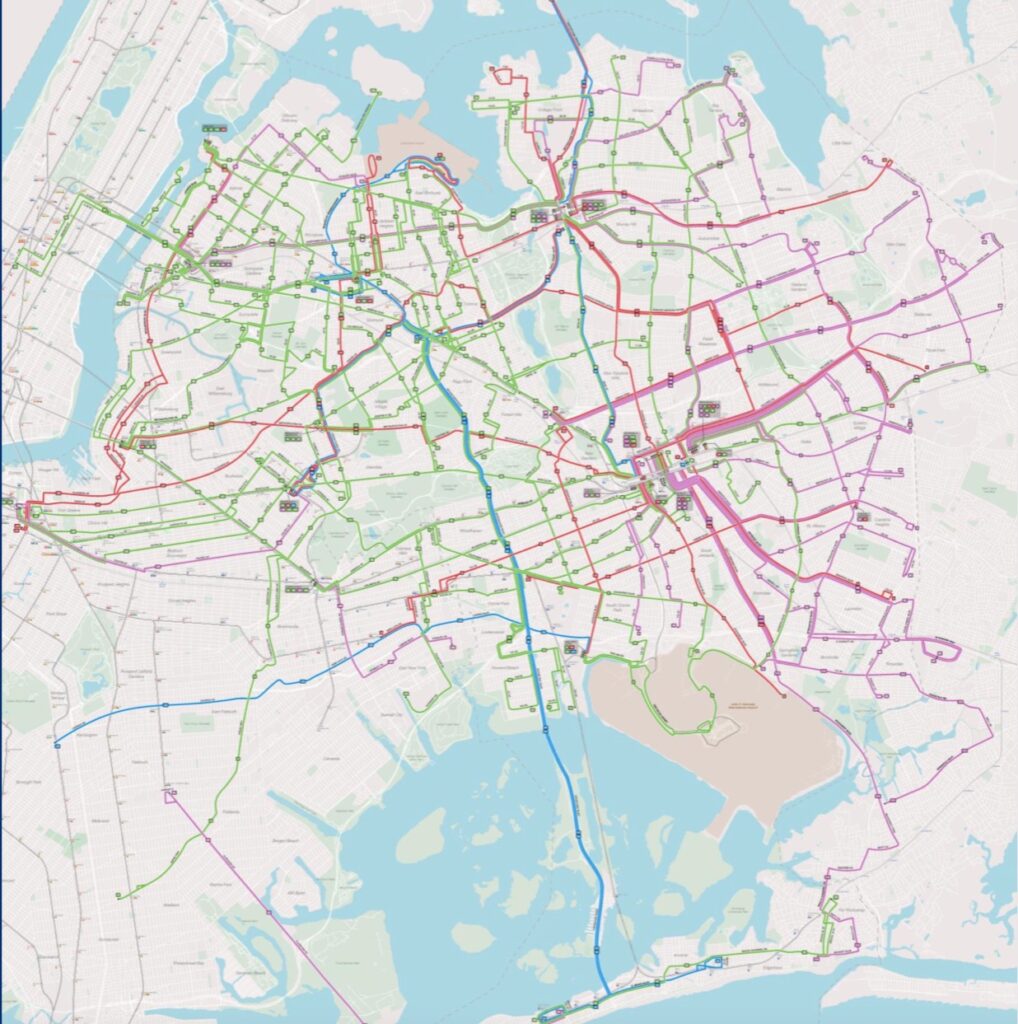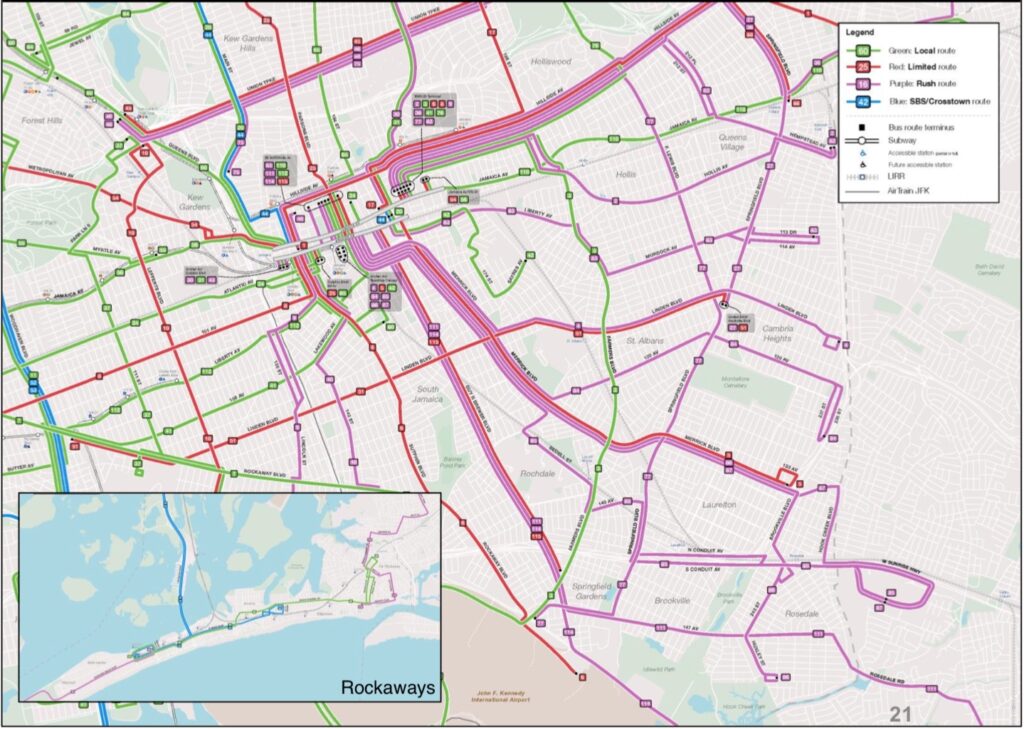By Celia Bernhardt | cbernhardt@queensledger.com
The MTA unveiled its final proposal for the Queens Bus Network Redesign last week, taking another stab at reconfiguring bus routes in the borough.
The $30 million dollar plan would cut 10 existing routes, add 15 new ones, and tweak plenty of others.
Queens residents are more reliant on buses than boroughs with more extensive subway service, like Manhattan and Brooklyn; roughly 800,000 Queens residents board a bus on an average weekday. But riders have had to make do with a bus system with declining on-time performance (a 12 percent decrease from 2014 to 2018) and bus speeds (from nine miles per hour in 2015 to 8.7 miles per hour in 2019).
MTA efforts to remedy that decline with a full redesign have been in development since 2019. An original draft plan was published in 2020; after a fairly negative reception from the public and the onset of the COVID-19 pandemic, the initiative took a pause. Another draft plan was released in March 2022. It was described by the MTA as a “fresh look” at the redesign, taking direction from the outpouring of feedback in 2020. This newly-released iteration, the Proposed Final Plan, builds on 2022’s feedback.

Full-borough redesign map. Courtesy of the MTA
A change permeating the design as a whole is increased spacing between bus stops. This would force some riders to walk farther in their daily commute, but the MTA says it should ultimately make the buses faster and more reliable; the plan states that removing one stop saves riders about 20 seconds per trip. The agency also aims to straighten out routes that may have too many twists and turns to create faster, more direct service.
The plan proposes new “rush routes,” designed to pick up residents in the Northeast and Southeast sections of the borough less served by transit and get them to subway stations fast, with fewer and fewer stops as the bus nears its destination. The MTA also highlighted changes to its express lines—one new proposed line, the QM65, would link Laurelton and Rochdale to downtown Manhattan.
The transit agency kicked off its long road of feedback with a series of closed-door meetings with local stakeholders in different quadrants of the borough. Next, the agency will visit all 14 community boards in Queens, where constituents will be able to speak their minds about the proposed changes.
Andrew Lynch, chief design officer at transit advocacy group QueensLink, expects plenty of pushback.
“It’s all about subjectivity,” Lynch said. “It’s all about ‘Are you reducing my stop?’ And you’re never going to win that battle…You have to cut something, you have to hurt someone’s commute to help everyone else’s commute.”
Lynch said that the mood among his colleagues in the transit world was generally positive towards the plan.
“I would say this: we’re relatively happy with where this is. There are always going to be small little changes where you’re like ‘That doesn’t make sense,’ or ‘Why’d they do that?’ that are probably too nitpicky. Because at some point, you just need to pull the bandaid off,” Lynch said.
Early Criticism from Southeast Queens Reps
Southeast Queens representatives have had some angst about the plan thus far. City Council Transportation Committee Chair Selvena Brooks-Powers said at a press conference that she had “serious concerns.”
“The changes proposed to help streamline and speed up service could also leave many people in my district at a severe disadvantage,” she continued. “Especially with the addition of congestion pricing in the city.” Brooks-Powers did not go into specific complaints at the press conference or in a follow-up statement released on Dec. 12.
State Senator Leroy Comrie also spoke, floating the idea that Brooks-Powers took issue with additional bus lines in Rosedale.
“We went from one bus line in Rosedale to four bus lines, and that’ll confuse people so she wants to see that cleaned up,” Comrie said.
Assemblymember Khaleel Anderson said that he also has concerns about how the plan will manifest in Rosedale.
“More buses sounds good, but I would say that there has to be more coordination on where those buses meet,” Anderson said. He argued that though more bus lines will run through the neighborhood, they won’t enable residents to traverse from one point in Rosedale to another.

Southeast Queens redesign map. Courtesy of the MTA
He also decried the alterations to the MTA’s planned Q51 route since its last form in the 2022 New Draft Plan: originally, the proposed route would connect Cambria Heights to Brooklyn’s Gateway Center mall via Lindenwood Boulevard. Now, it stops short at the Rockaway Boulevard A train station in Ozone Park. “You want to connect people to economic centers, to jobs, to resources, and that Q51 bus did,” Anderson said. “It was one of the most exciting, bold ideas that was out in the last plan, and I’m sad that it was taken out.”
But Anderson’s primary concern is the Rockaways.
“The glaring thing that stands out is that there’s no major changes to any of the routes that leave the Rockaway peninsula,” Anderson said. “When I think about…the hundreds, if not thousands of families we’re getting via the migrant shelter we have in our district—I’m thinking about moving more than the people we have presently on the peninsula.”
Lynch had a similar takeaway. “The Rockaways still have relatively poor east-west transportation,” he said. “The weird thing is that there’s literally no recommendations for change.”
“We need to be bold in Rockaway,” Anderson continued, suggesting a bus from the peninsula to JFK Airport and an extension of the Q52 bus further east.



